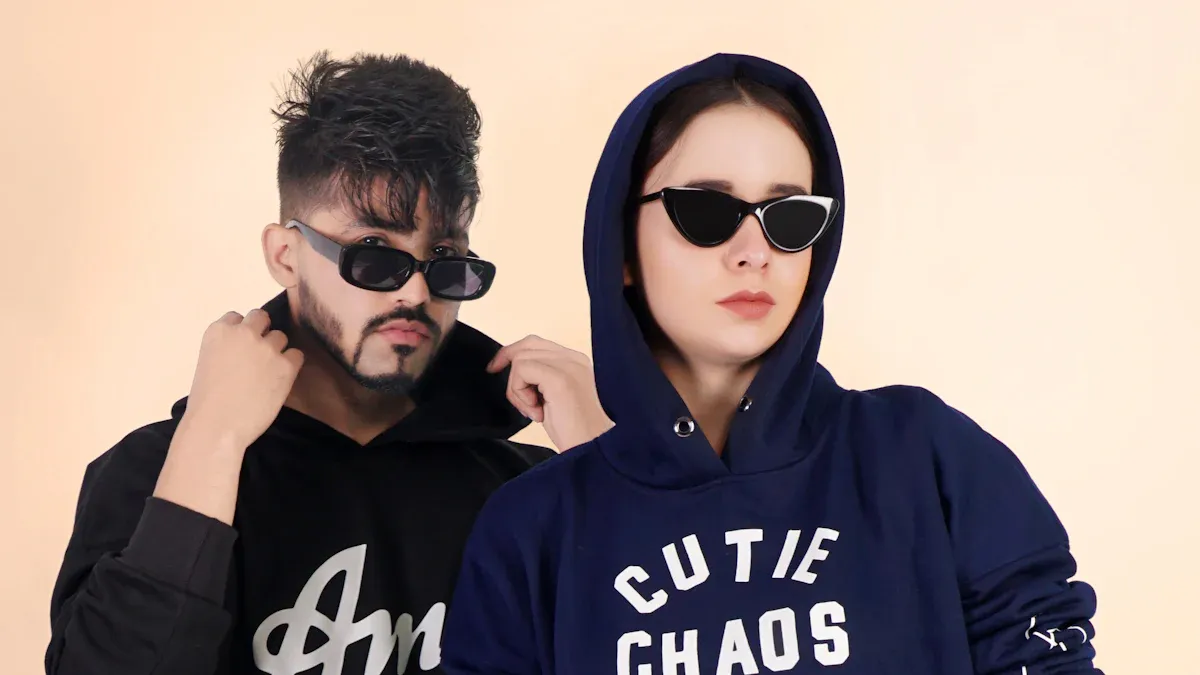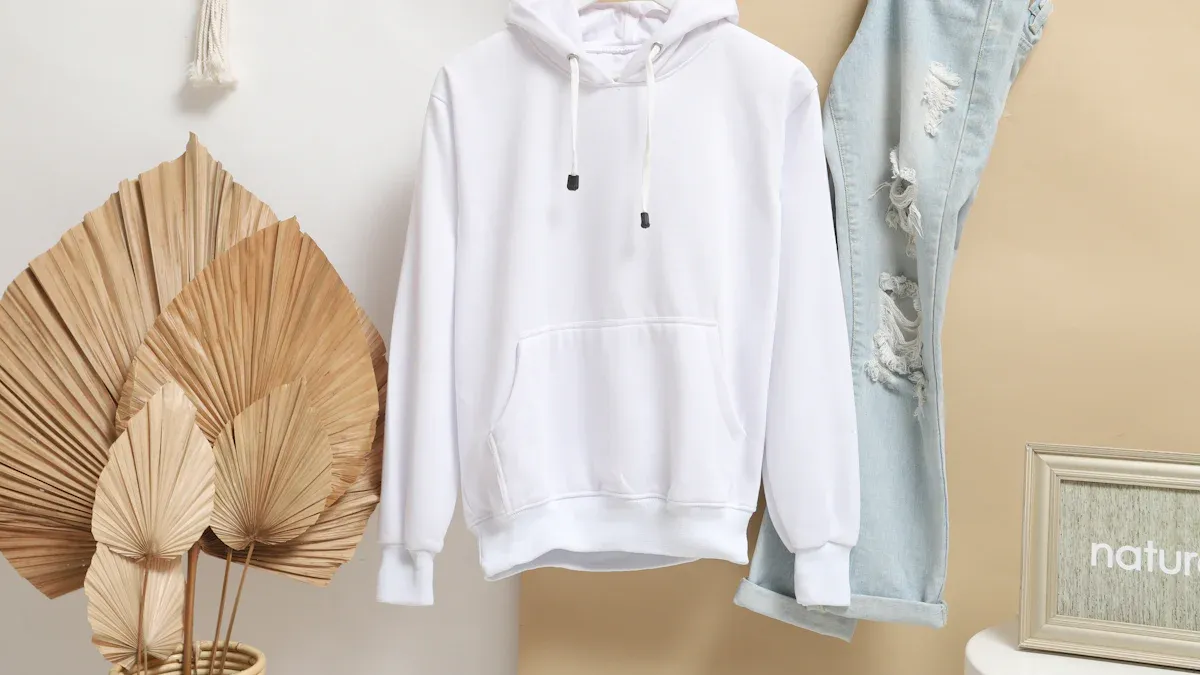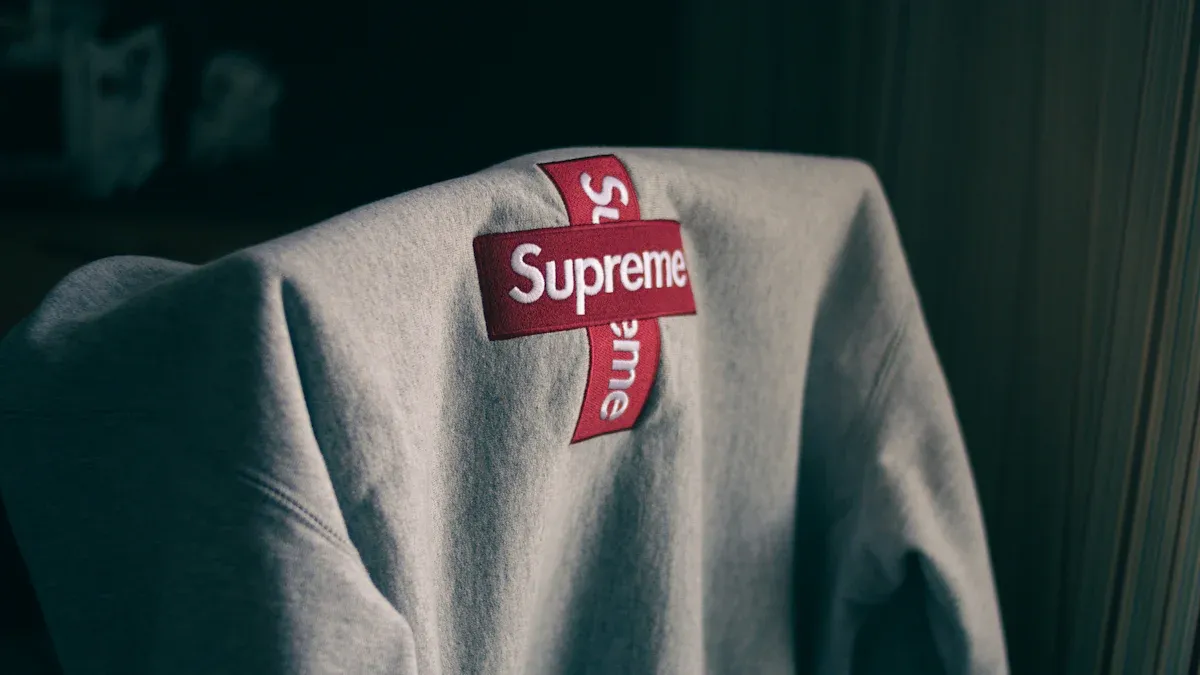
Sweatshirt brands stand out in 2025 by using great materials, new designs, and good customer service. Experts say brands use new fabric technology, features that do many things, and custom sweatshirt design and care to get buyers. People want sweatshirts that feel good, look nice, and are good for the planet.
Top brands do well by using online shopping, high quality, and styles you can wear many ways.
Segment | Value/Trend |
|---|---|
Global Market Size (2023) | $36 billion |
Projected (2030) | $50 billion |
E-commerce Apparel (2025) | $1.5 trillion |
Key Takeaways
The best sweatshirt brands use good fabric blends. They pick cotton-polyester and tri-blends. These make sweatshirts soft and strong. The sweatshirts do not shrink easily.
Custom designs and personalization help brands connect with people. This makes sweatshirts special and important to buyers.
Eco-friendly materials and fair practices build trust. They attract people who care about the Earth and fair work.
Good customer support and clear care instructions help buyers. Easy online shopping makes people happy and want to buy again.
Digital tools like social media, AI, and online events help brands. These tools let brands talk to customers and make fun groups.
Materials and Quality

Fabric Blends
In 2025, sweatshirt brands use new fabric blends for better comfort and quality. Cotton is still the top choice for sweatshirts. Many brands mix cotton with polyester or other fibers for better results. These blends help stop shrinking and keep sweatshirts looking nice longer.
Fabric Blend Type | Typical Composition | Key Benefits and Characteristics |
|---|---|---|
Cotton/Polyester Blends | 50/50, 65/35, 80/20 ratios | Cotton is soft, and polyester makes it strong and helps with sweat. These blends are comfy, last long, and are easy to care for. 50/50 blends do not wrinkle much and keep their color. 65/35 blends feel softer and hold their shape. 80/20 blends feel like cotton but last longer. These are great for daily wear and custom sweatshirts. |
Tri-Blends | Cotton + Polyester + Rayon or Elastane | These fabrics are very soft, light, and stretchy. For example, 50% polyester, 25% cotton, and 25% rayon feels smooth and soft. Elastane in the blend adds stretch and helps sweatshirts keep their shape. These are popular in fancy and stylish hoodies. They feel buttery and very comfortable. |
Top brands pick these blends because they make sweatshirts comfy and strong. Cotton/polyester blends like 50/50, 65/35, and 80/20 are soft and tough. Tri-blends add rayon or elastane for more stretch and a smoother feel.
Blend Ratio (Cotton/Polyester) | Comfort | Durability | Shrinkage Resistance |
|---|---|---|---|
50/50 | Soft and strong | Lasts long and does not wrinkle much | Shrinks less than all-cotton |
65/35 | Feels natural and lets air in | Stronger and does not wrinkle much | Shrinks less than blends with more cotton |
80/20 | Soft and lets air in, some wrinkle resistance | Strong fabric and seams last longer | Hardly shrinks and keeps its shape |
Fabric Type | Comfort | Durability | Shrinkage Resistance |
|---|---|---|---|
Cotton | Soft, lets air in, good for sensitive skin | Lasts long if it is high quality, but wrinkles easily | Can shrink and lose shape after washing |
Polyester | Not as soft or airy | Very strong, does not wrinkle, keeps color | Almost never shrinks |
Blended (Cotton-Polyester) | Stronger than just cotton, does not wrinkle or shrink much | Shrinks less than all-cotton, keeps shape and color |
Durability
Durability is important for sweatshirts. Cotton makes sweatshirts soft and airy, but pure cotton can shrink and lose shape after washing. Polyester makes sweatshirts stronger and helps them last longer. Mixing cotton and polyester makes fabric that does not shrink and keeps its color. Tri-blends, which mix cotton, polyester, and rayon or elastane, make sweatshirts even stronger and stretchier. These blends help sweatshirts keep their shape and look nice after many washes.
Note: Sweatshirts with more polyester usually last longer and shrink less than all-cotton ones.
Care
Taking care of sweatshirts helps them last longer. Brands that give clear care instructions help customers keep their sweatshirts nice. Good care tips show how to wash and dry sweatshirts to stop shrinking and damage. This means fewer returns and more trust between brands and buyers.
Custom care labels give easy washing tips and help people keep sweatshirts nice.
These labels look professional and show the brand cares.
Teaching people about care stops damage and keeps sweatshirts looking new.
Special care labels make products stand out from others.
Good care tips make customers happy and loyal because they know the brand cares about how long sweatshirts last.
Brands also help by giving sizing guides and measurement tips. They use good pictures and videos to show how sweatshirts really look and fit. After buying, brands help with live chat, FAQs, and emails. They make it easy to exchange sizes if needed.
Studies show people trust brands that care about quality and how long sweatshirts last. Clear care tips help people keep sweatshirts in good shape, so they are happier and more loyal. When brands care about the customer’s experience, people want to buy again.
Custom Sweatshirt Design and Care

Design Elements
Sweatshirt brands in 2025 want to make buyers happy. They do this by making custom sweatshirts and giving good care tips. Top brands use special features to make their hoodies different. Many sweatshirts use thick cotton, preshrunk fabric, and cool pockets like kangaroo or hand warmer pockets. Some brands add custom embroidery or tie-dye designs to make them look better. Others use soft sponge fleece for extra warmth and comfort.
Brands like Patagonia use recycled materials and Fair Trade certification to help the planet. Nike and Carhartt make sweatshirts strong with triple-stitched seams, rib-knit cuffs, and drawcord hoods. Topo Designs and North Face use old-school details, bright colors, and useful pockets. Arc’teryx uses special fabrics that do not get sweaty or wrinkled. These choices help brands connect with their fans and build a strong brand image.
Tip: Sweatshirts with ribbed cuffs, pouch pockets, and many color choices get good reviews and sell well.
People in 2025 want sweatshirts that fit their style and values. Simple designs with clean lines and soft colors are good for people who like a plain look. Old-fashioned styles are great for people who like things from the past. Big fits and graphic prints are still cool for showing off your style. Brands with lots of colors, from browns to bright neons, can reach more people. Custom sweatshirt design and care help make these sweatshirts more fun and useful.
Font Choices
Font choice changes how people see a brand. Brands pick fonts to show what they are like and to connect with buyers. Serif fonts look classic and make people think the brand is trustworthy. Sans serif fonts look modern and simple, so brands seem new and friendly. Script fonts look fancy and creative, and display fonts help brands stand out with bold looks.
Studies show font choices change how people feel about a brand. Friendly fonts make a brand seem more honest. Fancy fonts make a brand look expensive. Using the same font on websites, labels, and social media helps people trust and remember the brand. For custom hoodies, fonts must be easy to read on all fabrics and sizes. Brands that match their font to their style and audience make a stronger bond and keep buyers happy.
Note: Brands like Apple and Coca-Cola use the same, easy-to-spot fonts to build trust and help people remember them.
Personalization
Personalization is now a big part of custom sweatshirt design and care. Brands let people add names, logos, or pictures to their hoodies. This makes each sweatshirt special and lets buyers show their style, hobbies, or beliefs. People can pick embroidery, screen printing, and choose colors or patterns.
Letting people personalize sweatshirts makes them happier and more loyal. Customers feel special when they can make something just for them. Studies say people who personalize their hoodies will buy again. Giving personal tips and shopping ideas also makes people happier and more interested. Brands that use customer info to suggest products or give care tips get more repeat buyers and keep customers longer.
Personal touches make customers feel important and keep them coming back.
Custom printing and embroidery let people make sweatshirts their own.
Personalization makes people spend more and return to buy again.
Custom sweatshirt design and care also means giving clear care tips for special items. Brands give easy washing tips to help people keep their hoodies looking new. This care builds trust and makes the brand more liked. When brands care about both design and care, their sweatshirts stand out and keep customers happy.
Sustainability
Eco Materials
Many top sweatshirt brands in 2025 use eco-friendly materials. They pick fabrics that are good for the planet and feel nice to wear. Brands like Yes Friends use only organic cotton in their sweatshirts. This cotton grows without bad chemicals or pesticides. Tentree uses both organic and recycled materials. They use recycled cotton, TENCEL™ Lyocell, and recycled polyester. These brands also help by planting trees and running recycling programs.
Environmental Impact & Features | Certifications / Notes | |
|---|---|---|
Organic Cotton | Grown without chemicals or pesticides; avoids fertilizers; reduces chemical exposure; high water and energy use but more sustainable than conventional cotton. | GOTS, Fairtrade |
Modal | Made from beech tree pulp; closed-loop chemical recovery process recycles 99% solvents and water; soft and breathable. | OEKO-TEX, FSC (for sourcing) |
Bamboo Lyocell | Fast-growing bamboo; no pesticides or much water needed; closed-loop production recycles solvents and water; no harsh chemicals. | OEKO-TEX, FSC |
Piñatex | Made from pineapple leaf waste (a byproduct); no extra land or water needed; production uses some chemicals mainly for coating; vegan and cruelty-free. | PETA Material Innovation Award, European Commission Seal of Excellence |
Peace Silk | Silkworms allowed to emerge naturally; less energy and water use than conventional silk; some chemical use in degumming but generally lower. | GOTS (some producers) |
Cashmere | Renewable and biodegradable; risk of overgrazing causing desertification; labor-intensive harvesting; ethical standards promoted by Sustainable Fibre Alliance. | Sustainable Fibre Alliance |
Alpaca Wool | Light grazing reduces environmental damage; less energy and water in processing; no harsh chemicals; biodegradable. | Climate Beneficial by Fibershed, Woolmark, RWS |
Deadstock Fabric | Uses leftover fabric, reducing waste and resource use; environmental impact depends on original fabric production methods. | Varies; transparency needed |
ECONYL® | Made from recycled nylon waste including fishing nets and landfill plastics; reduces waste and pollution; durable and shape-retaining. | Produced by Aquafil |
Lots of brands now use organic cotton, recycled cotton, and plant-based fibers. These choices help cut down on pollution and save resources. Sweatshirts made from these materials are soft and last a long time. Using eco-friendly materials helps brands get buyers who care about the earth.
Brands that use eco materials show they care about people and the planet.
Ethical Practices
Ethical practices help sweatshirt brands stand out. These brands make sure workers are safe and get fair pay. They use outside groups to check that their factories follow strict rules. Some common certifications are GOTS, Fair Wear Foundation, and SA8000. These groups check that brands treat workers well and protect nature.
Certification Name | Focus Area(s) | Ethical Verification Aspect |
|---|---|---|
SA8000 | Labor and social ethics | Ensures ethical and socially responsible manufacturing practices, fair treatment, and workforce well-being. |
WRAP | Labor and social ethics | Emphasizes lawful, humane, and ethical manufacturing practices globally. |
Fair Wear Foundation | Labor conditions in garment production | Conducts audits and training to promote fair working conditions in sewing and trimming processes. |
GOTS | Environmental and social standards | Certifies organic fibers and ensures social and environmental responsibility throughout the supply chain. |
Bluesign® | Environmental and occupational health safety | Sets stringent standards to eliminate harmful substances early in textile manufacturing. |
Fair Trade | Social and environmental accountability | Emphasizes fair wages, safe working conditions, and sustainable farming practices. |

Being open about where materials come from builds trust. Brands like Patagonia tell people where they get their cotton and how they make sweatshirts. This honesty makes shoppers feel good about buying. Studies show most people like brands that share how they make things and use fair practices. Brands that stay honest get loyal customers and a good name.
Tip: Brands can use blockchain and outside checks to prove their supply chain is fair and open.
Customer Experience
Digital Engagement
Sweatshirt brands in 2025 use digital tools to connect with customers. They post nice photos and videos on Instagram and Pinterest. These sites help brands show new styles and let people share their own sweatshirt pictures. Brands use stories, polls, and shopping posts to make buying fun.
On Facebook, brands talk about their history and what they believe in. They share what customers say and do live videos or special events. Twitter helps brands give news, announce sales, and join popular topics. Influencers and micro-influencers show off their favorite sweatshirts. This helps brands find new fans.
Some brands use special ideas to get people excited. They have limited drops and special events. They use hashtags and contests so customers can join in. Many brands use AI to suggest items and make shopping feel special. Augmented reality lets people try on sweatshirts online. These things help brands build a loyal group and keep customers coming back.
Tip: Online groups let customers share ideas, join fun challenges, and feel like part of the brand family.
After-Sales Support
After-sales support is important for keeping customers happy. Top sweatshirt brands give free returns, fast shipping, and easy exchanges. Some companies let you return items for 100 days and give fashion tips. Others have live chat and email help to answer questions fast.
Brand Name | After-Sales Support Features | Extra Benefits |
|---|---|---|
Fashiongo | Personalized consultations, tailored solutions | Focus on quality and sustainability |
Clothing Shop Online | Free 100-day returns, fast shipping | Bulk discounts, wide brand range |
SanMar | Comprehensive support, reliable distribution | Custom apparel, marketing tools |
Brands that reply to reviews and thank customers build trust. Good reviews show a brand cares about making people happy. When brands fix problems fast, customers feel important and want to buy again. Free repairs or loyalty rewards make people want to share good stories. These things help brands stand out and keep customers for a long time.
A top sweatshirt brand in 2025 uses eco-friendly materials. It lets people design their own sweatshirts online. The brand also talks to shoppers using new technology. People want sweatshirts that match their style and what they care about. To do well, brands should:
Pick materials that are good for the planet and show where they come from.
Let people make sweatshirts their own and make shopping fun.
The best brands grow by using new ideas, caring for the earth, and putting customers first. The sweatshirt market will keep changing as brands meet new needs.
FAQ
What fabrics do top sweatshirt brands use in 2025?
Most top brands use cotton and polyester blends. They also use eco-friendly materials like organic cotton or recycled fibers. These fabrics are soft and last a long time. They also help protect the earth.
How can someone tell if a sweatshirt brand is sustainable?
Check for certifications like GOTS, Fair Trade, or Bluesign®. Brands usually share info about their materials and factories on their websites. 🌱
Why do brands offer custom sweatshirt designs?
Brands let people personalize sweatshirts to show their style. Personalization makes each sweatshirt special. It helps people feel closer to the brand.
What makes a sweatshirt last longer?
Good fabric blends and strong stitching help sweatshirts last. Clear care instructions help keep their shape and color. Following the care label stops shrinking and damage.









